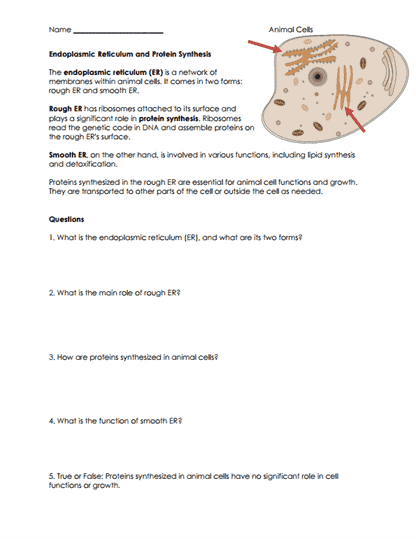Endoplasmic Reticulum and Protein Synthesis

Worksheet Description
This worksheet delves into the subject of the endoplasmic reticulum (ER), a key cellular organelle found within animal cells. The ER, depicted in the associated diagram, is highlighted in its two main forms: the rough ER, characterized by ribosomes on its surface and its role in protein synthesis, and the smooth ER, associated with lipid synthesis and detoxification. Through textual descriptions, the worksheet details the distinct functions and characteristics of both ER types. The subsequent questions aim to assess the student’s comprehension of the ER and its role in cellular processes.
To effectively engage with the content, students should begin by meticulously reading the detailed descriptions, paying special attention to the differences between rough and smooth ER. The accompanying visual aids in understanding the organelle’s structure and its position within an animal cell, reinforcing the written information. Once the foundational concepts are grasped, students can tackle the questions, leveraging their newly acquired knowledge to craft informed answers. To solidify understanding, it’s advisable to revisit the primary content and verify responses, ensuring comprehensive learning.
The worksheet seeks to equip students with a robust understanding of the endoplasmic reticulum and its pivotal roles within animal cells. By distinguishing between rough and smooth ER, the material emphasizes the organelle’s multifaceted functions, from protein synthesis to lipid production and detoxification. Through this exploration, students are encouraged to recognize the integral contribution of the ER to cellular health and functionality. The posed questions serve both as an evaluative tool and a means to reinforce key concepts, ensuring students emerge with a well-rounded comprehension of the topic.
